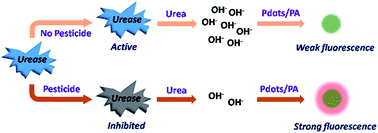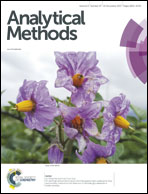pH-controlled fluorescence changes in a novel semiconducting polymer dot/pyrogallic acid system and a multifunctional sensing strategy for urea, urease, and pesticides†
Abstract
A novel multifunctional semiconducting polymer dot (Pdots)/pyrogallic acid (PA) system was successfully established for fluorescence sensing of urea, urease, and pesticides. The Pdots/PA system was pH controllable, emitting strong fluorescence at pH 6.0. However, in an alkaline environment, PA transformed into its quinone structure, which is an efficient fluorescence quencher, resulting in fluorescence quenching of the Pdots/PA system. Furthermore, urea was hydrolyzed in the presence of urease, releasing hydroxyl groups that transformed PA into its quinone structure, resulting in fluorescence quenching of the Pdots/PA system. Therefore, a sensitive detection method for urea and urease was developed. The limits of detection for urea and urease were 0.02 mM and 0.08 U L−1, respectively. Pesticides, such as dimethoate, were able to inhibit the urease activity, resulting in recovery of the fluorescence intensity of the Pdots/PA system. Therefore, the fluorescence turn-on detection of pesticides could be also achieved. A satisfactory result was obtained when using the system to detect pesticides in fruit and vegetable samples.



 Please wait while we load your content...
Please wait while we load your content...